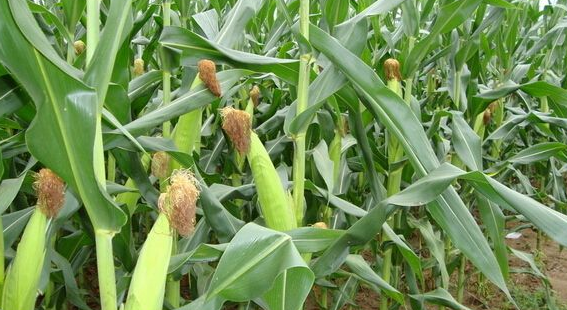Mexican corn, also known as yarrow, is native to Central America and Mexico. The variety is genetically stable, with strong tillering and regenerative properties; good palatability, resistance to pests and diseases, high yield and high quality, and a single fresh grass up to 11 kg. The crude protein produced in the same area is 4-5 times that of ordinary corn. It is an excellent green fodder for herbivores, poultry and fish.
(1) Botanical characteristics are annual herbaceous plants of the genus Gramineae. Tufts, thick stems, erect, 1.5-2.5 m high, up to 5 m, leaf length 70-90 cm, width 8 cm. It has strong tillering, 30-60 branches per cluster, more than 90 branches, thick stems, lush foliage, crisp texture and sweet taste. The seeds are brown or taupe and weigh 77 grams.
(2) Biological characteristics. Hi warm and humid climate, heat-resistant and cold-resistant, growing rapidly at 18-35 ° C, the frost gradually withered, like big fat water, the soil is not strict, both acid and slightly salt-tolerant, slightly resistant to water stains. The growth period is about 210 days, and the regenerative power is strong. It can be castrated 7-8 times a year, and the fresh grass is 1-2 square kilograms per mu.
(3) Cultivation techniques. Choose land with medium fertility above medium and convenient water source, deep tillage, apply 1500 kg of organic fertilizer per acre, and 25 kg of phosphate fertilizer. Appropriate sowing period 3-4 months, can be broadcast live, but also seedling transplanting, or seedling transplanting, 0.5 kg per acre. The seeds were sun-dried for 2 hours before sowing, and then soaked in warm water at 25 ° C for 8 hours. The seedbed was filled with water, and the film was covered after sowing, and the arch was 50 cm from the bed surface. The film can be ventilated when the weather is too hot. Because the seedlings are similar to corn and sorghum seedlings, they should not be broadcast together to avoid confusion. When the seedling age is about 25 days, when the plants are 3-4 leaves, apply a small amount of urea or thin manure water, and peel off the film for another 5 days; the plant has 5 leaves, and the temperature is not lower than 15 °C when transplanting, in the afternoon Appropriate, the row spacing is 40-45 cm × 50-60 cm, planting 1-2 plants in one hole, and planting the land and the appropriate soil fertility. After planting, you should pour enough water to survive for 5-10 days. The seedlings have a "seedling period" of nearly one month. During this period, the plots with no phosphate fertilizer, the leaf tips and even the whole leaves will gradually become red, affecting the development of the root system, and the phosphate fertilizer should be supplemented. When the seedling height is 30 cm, 6 kg of nitrogen fertilizer is applied per mu, and the soil is cultivated in the middle to promote the tillering. After each castration, the seedlings will grow 5 cm in height, that is, they should be topdressed with fertilizer and pay attention to dry irrigation.

(4) Casting methods. Mexican corn has a high dry matter content of more than 13% crude protein, 0.42% lysine content, and 14.6 MJ per kilogram of digestion energy. The plant height can be castrated by 1 meter. The height of the castration is 10-15 cm. If it is not left, it cannot be regenerated. The edge of the knife should be cut into a slope to prevent the rain from staying on the cutting mouth. After each castration, the height of the stubble is increased by 2 cm, and the growth point cannot be cut off, which affects regeneration. After the application of nitrogen fertilizer, 15-20 kg per mu, you can not put the fertilizer on the mouth. Also don't castrate on rainy days.
(5) Feeding techniques. Cattle, sheep, etc. can be fed directly, chicken, fish, goose, etc. should be chopped and then fed; the quality of silage is also excellent; crabs are also very fond of food, the method is castration when the grass is 50 cm high, tied into small bundles, Tied with rope, thrown in the crab pool, pull the rope after 2-3 hours, recover the residual stem, and feed the cattle and sheep after drying; 22 kg of stems and leaves can grow 1 kg of fresh fish; feed cows, daily average The milk yield is 4.5% higher than that of ordinary green corn.
(6) Breeding methods are numerous. Some measures can be taken in the middle and lower reaches of the Yangtze River to harvest some mature seeds. But the flowering period should be staggered with the corn, otherwise it will hybridize. Seeds are often wormed in the next year and cannot be reused. Stem. The middle and lower stalks can be directly cut and propagated by digging a 10 cm deep narrow ditch and burying the stalk directly into the soil; or cutting the stem nodes in the middle, there are two flower buds on each section, obliquely inserted into the soil, about 10 There are sprouts growing in the days. But this method is more troublesome and generally not used.
Amino acid
Amino acid,Acetylcysteine,l-Theanine,L-cysteine,l-carnitine,L-Glutamine
PYSON Co. ,Ltd. , https://www.pysonbio.com